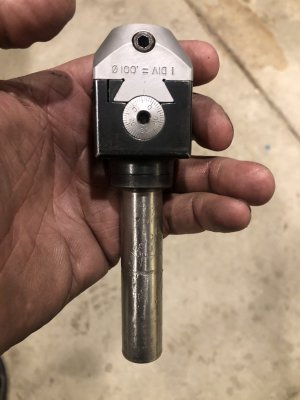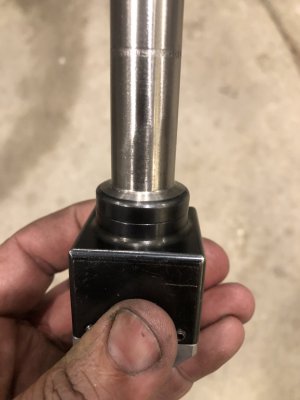Thank you for all of the helpful responses. I can see that the boring head being square makes it easier to hold in a vise. It had not occurred to me to hold it in a milling machine vise.
I have an 8” Kurt vise, but I sure would not want to cause harm to that vise or the table on the milling machine.
I have broken a Chinese 4” bench vise using a cheater bar. That set me back over $100 to replace the bench vise.
I love this little boring head, & I don’t think that I would have the money to replace it were I to deform it under torsion while it is clamped in a vise.
It seems like I would have a better chance of success if the leverage were applied near the threads, as this would minimize any twisting in the 3/4” shank. This plan has me machining a hex on the shank near to the threads, & then using a wrench with a cheater bar (if necessary).
If this fails, I would feel very comfortable drilling & boring out the shank. I would hold the square head in a 4J (with soft jaws!) & just make sure to stop short of the crests of the threads on the boring head.
Having said all the above, I will likely stick weld a long piece of 3/4” round or hex bar to the end of the shank. Talk about a bend test, right?
Do we expect that the shank is medium carbon steel (such as 1045)? Does anybody see any reason not to use a 6010 electrode? The only other choice is 7018.
Would you guys choose round or hex bar? I will probably make it very long, & increase leverage (by moving my hands farther apart) as needed.
I will soak the threads for a long time in an appropriate thread loosening compound, this after the welding job. If you think about it, this has the whole head soaking in a vessel of thread loosening compound for about 7 days. I wonder if that might present a problem for the boring head; Heck, maybe it would provide excellent lubrication for the head!
We note that the soft jaws (which will be aluminum) for the bench vise & 4J (copper soft jaws if I resort to drilling & boring) need to have some areas machined out because there are 3 set screws that need to be protected. I would be afraid to remove the screws because I know there are ball bearings under the set screws, & Murphy’s Law has me losing exactly one of these ball bearings.
All of this trouble to “upgrade” to a quality R8 shank.





